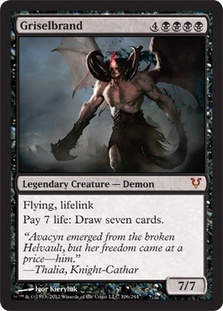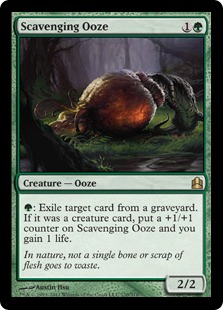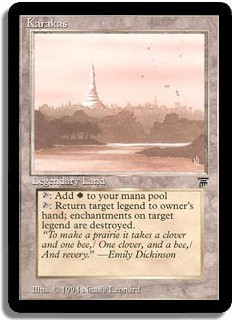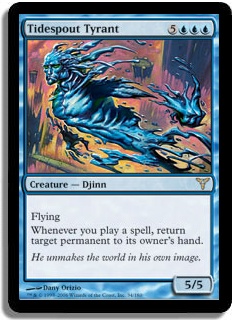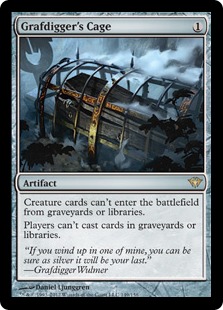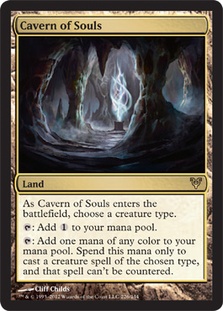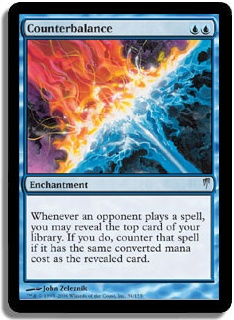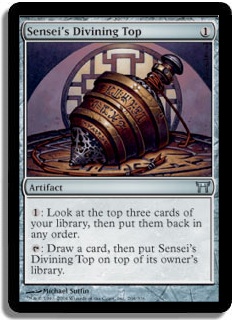In a move that is totally selfish on my part in that I can send one email to Lauren instead of one hundred emails to everyone else that’s asked me for decks over the past few weeks, you’re getting to read this article today in which I’ll review the top tier of Legacy. I can’t decide if this shows initiative or a supreme dedication to a certain kind of laziness.
Before we dive in, keep in mind that this is not meant to be an all-inclusive list; a number of decks that are still popular regardless of viability (Burn, Affinity), those that are viable but niche (Nic Fit, various builds of Storm, High Tide),and decks I just skipped because I felt like it (Aggro Loam) have been omitted.
What follows are the decks you absolutely need to know and understand before seriously competing in the current Legacy metagame.
Disclaimer: if you eat at Subway and actually get avocado on your sandwich at Subway, you’re not welcome in my article because that is, frankly, disgusting and you should be ashamed.
Sneak and Show
Creatures (8)
Lands (15)
Spells (37)
- 4 Brainstorm
- 4 Show and Tell
- 4 Force of Will
- 1 Mountain
- 3 Island
- 2 Intuition
- 3 Misdirection
- 4 Sneak Attack
- 4 Lotus Petal
- 4 Ponder
- 3 Spell Pierce
- 1 Preordain
Sideboard

Sneak and Show decks are nothing new to the Legacy format, but are instead part of a wide group of decks that have improved dramatically over the last four years. Wizards has continued to raise the bar for strategies that cheat creatures into play (such as Oath of Druids, Reanimator, Show and Tell, and Sneak Attack) by continuing to print ever more ridiculous creatures. The options have dramatically improved thanks to creatures like Progenitus, Emrakul, Jin-Gitaxias, and now Griselbrand.
Seriously, if those other creatures are the Avengers, then Griselbrand is the Hulk wearing a giant purple suit of Iron Man armor, wielding Thor’s Hammer and an American Flag while Scarlett Johanson waits at home for him in bubble bath.
What is it about Griselbrand that has turbo-charged this strategy? While using Show and Tell or Sneak Attack to cheat in an Emrakul is still as viable as ever, it might actually now be the back-up plan. When Griselbrand drops into play via Sneak Attack, it is relatively common for the deck to “combo out” via Lotus Petal and another activation into Emrakul, the Aeons Torn. Those two attack together to end the game on the spot. Using Show and Tell to drop in Griselbrand is similarly ludicrous, as the deck packs plenty of counters to protect him, attacking into him doesn’t accomplish that much, and untapping with Griselbrand almost always ends the game.
Compared to Hive Mind, Sneak and Show decks need less space dedicated to the combo kill (those stupid Pacts) and are therefore more consistent. You also don’t need to understand the stack all that well, which is a plus. And, unlike the older Sneak and Show decks that paired Emrakul with a back-up creature like Progenitus or Woodfall Primus that was good but clearly an inferior strategic option, this version is probably going to beat you if it fires either of its namesake cards with either creature.
As far as the specific list I’ve linked to, I think the maindeck is pretty much optimal. Intuition is terrific in these Sneak and Show decks, and Spell Pierce and Misdirection give it plenty of pushback against the counters of decks like RUG and Stoneblade. I also really like the Grafdigger’s Cage in the sideboard; this card is criminally underplayed in the format right now. I might suggest playing three or four copies of Blood Moon, not only because it gives you another powerful “auto-win” card out of the sideboard against certain strategies, but also because it trumps Karakas.
While I personally don’t think this deck is so good as to necessitate the banning of Show and Tell, it is absolutely one of the tier 1 strategies in Legacy. While it is popular, Spell Pierce is going to be one of the stronger cards in decks like RUG and Merfolk, and I also think Blue Elemental Blast is a card worth considering out of the sideboard.
RUG Delver
Creatures (11)
Lands (19)
Spells (31)

Threshold strategies have a long and storied history in Legacy, and the latest incarnation of these decks is the extremely popular RUG Delver.
Obviously the card that returned this strategy to prominence in Legacy is its namesake, Delver of Secrets, which seems custom-designed for this type of strategy. As the format changes around it, we’ve seen the deck’s components shift between the use of Stifle, Spell Pierce, and Spell Snare. Also debatable is the use of Forked Bolt or Chain Lightning, though I tend to be a Forked Bolt man myself.
Ali Aintrazi list is very solid, and it is within a few cards of what I’d play myself if I were to play RUG. If you’re not comfortable with shaving a creature, I’ve seen lists that shave a Daze instead. Also worth considering is moving the sideboard Scavenging Ooze to the maindeck over the fourth Tarmogoyf, which has become relatively common.
Thought Scour has been my least favorite card in this deck for some time, and I’d discussed replacing it with one or two with Life from the Loam, which typically sits in the sideboard, so I’m glad to see I might’ve been on the right track there. There’s obvious synergy with Wasteland, and Loam is a perfectly good way of powering up Tarmogoyf and gaining threshold for whatever the plural of Mongoose is.
That said, while playing RUG I did wonder if it might be worth playing one Forest in the sideboard and changing the fetchlands to four Misty Rainforest and four Wooded Foothills. It really depends on what the format looks like, how many Wastelands you’re up against, and how those Wasteland decks support that strategy against RUG; cards such as Surgical Extraction or sideboarded Life from the Loam can make the postboard RUG matchup an awkward resource battle that the deck doesn’t really want to engage in.
Some sideboard cards to consider here include Grafdigger’s Cage, which is so easy for this deck to protect and helps the Dredge and Reanimator matchups, and Blue Elemental Blast if your metagame is infested with Sneak and Show.
RUG doesn’t do anything spectacular, but it is both popular and solid and shouldn’t be going anywhere in the near future. Keep it on your short list and test against it regularly.
Maverick
Creatures (25)
- 4 Mother of Runes
- 1 Scryb Ranger
- 2 Aven Mindcensor
- 1 Gaddock Teeg
- 4 Noble Hierarch
- 4 Knight of the Reliquary
- 3 Qasali Pridemage
- 2 Scavenging Ooze
- 3 Thalia, Guardian of Thraben
- 1 Ulvenwald Tracker
Planeswalkers (1)
Lands (23)
Spells (11)

Of all the decks in this list, Maverick may be the one of the two recently dominant decks showing the most signs of slowing down (with the other being Stoneblade). I still think it is a viable and powerful strategy, and one which is actually far less fair that it looks on paper.
Todd’s list is typical of what I look for in a Maverick list, although there are certainly some choices worth discussing. I’m all for the singleton Ulvenwald Tracker (the first rule of Fight Club…), but not as convinced on the two Aven Mindcensor; I would probably play at least one Fauna Shaman, and you might be able to talk me into a second Scryb Ranger relatively easily.
Given the state of the format and downturn in Maverick, I’m also not sure I’m sold on Garruk Relentless. I think you want another straight-up removal spell like Path to Exile in that spot. Garruk is relatively spicy if your format is full of fair decks, though you could make an argument for Elspeth in that slot. Similarly, I know everyone is jamming Cavern of Souls in Maverick, but I’m not confident in it as two-of instead of a singleton; the makeup of the format is such that the second Karakas might be good enough to go maindeck.
Gideon Jura is a pretty absurd card for the mirror, so if people are playing Maverick in your area, consider a second Gideon. I also struggle with the four Purify the Grave; as I said previously, I’m a big fan of Grafdigger’s Cage to push back against Dredge and Reanimator (even though in this deck, unlike RUG, you’re giving up your ability to use Green Sun’s Zenith, albeit in exchange for an outrageous strategic advantage).
I know Enlightened Tutor is a debated inclusion in the board, but personally I’ve found it useful as you can play powerful bullets (of varying quantity) like Choke, Circle of Protection: Red, Ethersworn Canonist, and Grafdigger’s Cage, and the Tutors allow you play as if you have several additional copies of those bullets. I could certainly be convinced that Tormod’s Crypt in sufficient numbers supported by Bojuka Bog is a reasonable option on the back of the swift pressure Maverick produces. And most likely, if you have a good enough read on the metagame, you want to skip the Tutors and just play the right cards.
I guess it’s that easy when you still get to, I don’t know, actually play a lot of Magic. For the rest of us, there’s Enlightened Tutor.
Crop Rotation is another card that warrants discussion in that it finds Bojuka Bog at instant speed, faster than Knight of the Reliquary, and also gets you Karakas in critical matchups like Sneak and Show and Reanimator. Also be aware of Peacekeeper, a spicy one-of in lists that play Fauna Shaman; some lists fold to it immediately, and others can’t beat Mother of Runes protecting Peacekeeper.
Reanimator
Creatures (7)
Lands (16)
Spells (37)

Reanimator is the second deck on this list that has been reinvigorated by the printing of Griselbrand. When we last saw Reanimator, it was one of the better decks in the Mental Misstep version of Legacy, powered in that build by Jin-Gitaxias. When Misstep was banned, Jin-Gitaxias became much more fragile—who knew he was Italian?—and the deck faded from prominence.
Well, good news for you Reanimator fans: Griselbrand is here to get your Entombs back into rotation. If you dig out some of the old Misstep lists, you’ll see that these versions are quite similar, with Thoughtseize slotting into the Misstep slot and Griselbrand replacing Jin-Gitaxias. Unlike Jin, you don’t really have to protect Griselbrand, as it is often enough to get one into play and then draw seven additional cards.
Who’d have believed that drawing seven cards led to brokenness? Inconceivable!
Having said that, if you can get Griselbrand out, it isn’t just the draw seven ability that is a problem (although that is certainly a huge problem). The 7/7 flying, lifelink body attached is in itself an issue, which again is a different situation than we saw with Jin-Gitaxias (where you usually needed a second creature to actually win you the game). Against Maverick, you have a similar situation where they don’t have counterspells, so you just have to typically protect against one Swords to Plowshares and you have an unbeatable creature in play with a draw ability to protect it for the three attack steps you need to win.
I used Max Tietze version here, but I suspect the optimal list is actually somewhere between this one and Gerry Thompson version in the same tournament. I’m not sure if it’s good or just exceptionally cool, but Gerry Thompson similar list has Vintage standout Tidespout Tyrant instead of Angel of Despair; there’s something sublime about this, as in many respects Tidespout Tyrant is going to serve as a better remover of permanents in that it is reusable and one that can also let you abuse your own Animate Dead if you need to switch up targets for some reason.
I also think I’d probably play Elesh Norn over Blazing Archon, and the ninth Reanimate spell is logical (though I think I’d probably go four Reanimate, three Exhume, two Animate Dead); I say that even though cutting the fourth Ponder to open up that slot seems like a tough move to make.
If you’re ready to get back on the Reanimator train, definitely rock the four Show and Tell and two City of Traitors plan out of the sideboard.
In case I haven’t made it obvious yet, I really think people should be playing more Grafdigger’s Cage in Legacy sideboards. For the moment no one is, so do what you will with your other sideboard slots, but one day people may actually wise up so it may be worth looking at potential answers.
Dredge
Creatures (23)
Lands (14)
Spells (23)

I recently wrote about Dredge, and still think it is a solid, if risky, choice for any Legacy event. The list I’d suggest starting with is Gerry Thompson from a few weeks back, though I’m torn between running the two Dread Return, one Flame-Kin Zealot, or playing the third Ichorid and fourth Cabal Therapy in the maindeck. Chances are, whichever way I would go, the sideboard would let me go to the other configuration, so at that point you’re just looking at the expected metagame and making a call.
Nether Shadow was Gerry’s choice to power into Dread Return postboard against decks that use Surgical Extraction or other means to try to prevent you from getting three creatures in play. It doesn’t attack all that well, but it does the job without any mana investment. One of my main problems with Nether Shadow is that there are no foil versions, so it impedes on my shininess. Other than that it seems solid, as you don’t need to draw Undiscovered Paradise like with Bloodghast and have no mana investment like Ashen Ghoul.
I stand by my belief that if you have to play Leyline of the Void, you probably shouldn’t be playing Dredge; the Nature’s Claim and Chain of Vapor package is the right call.
Especially if, you know, people wake up and start using Grafdigger’s Cage.
When Reanimator had Mental Misstep, I felt that the best graveyard deck advantage was squarely with Reanimator, both in general and certainly in the head-to-head matchup. It seems significantly closer today; Reanimator is more like playing actual Magic, while Dredge is higher in raw power.
Elves
Creatures (34)
- 3 Llanowar Elves
- 3 Priest of Titania
- 4 Wirewood Symbiote
- 2 Quirion Ranger
- 3 Fyndhorn Elves
- 1 Viridian Shaman
- 3 Birchlore Rangers
- 2 Mirror Entity
- 4 Heritage Druid
- 4 Nettle Sentinel
- 1 Regal Force
- 4 Elvish Visionary
Lands (13)
Spells (13)
Sideboard

If you’re surprised Elves in on the list, you probably don’t know how much I love Elves, and you also probably haven’t played against a competent Elves player. The deck is legitimate and can be built in a wide variety of ways. Well, I mean, all the varieties involve a crap-ton of Elves, so “wide” is probably a poor choice of words.
Chris Andersen has been one of the more recent advocates and has had success with Elves, so I’m using his most recent version from the SCG database. In addition to his version, there are builds using Living Wish, Summoner’s Pact, and Chord of Calling, all of which have had success. In my opinion, all are reasonable.
Mirror Entity itself isn’t an auto-include for me, as you have options like Ezuri, Renegade Leader, and Joraga Warcaller that are easier to Tutor for but are also less potent in terms of enabling the combo aspect of the deck. Your mileage may vary.
Elves has an issue with counters backed by pressure from Sneak and Show, Â as well as the speed of Dredge, so you need to have a solid sideboard plan for these strategies. Additionally, protection from spot removal is a necessity. Mark of Asylum is an option, Absolute Law is popular, and Steely Resolve is worthy of discussion.
Cavern of Souls might also be part of the Elves conversation, not only in that you can push out Elves with it but because you can more reliably use Regal Force against blue decks to put yourself into an unbeatable position; I could see it jockeying for position against Pendelhaven in some metagames. For the decks using one or more Crop Rotation it might be reasonable to look at a single Bojuka Bog in the sideboard, even though the lack of Knight of the Reliquary makes it less effective than it would be in Maverick.
MUD
Creatures (22)
- 4 Metalworker
- 3 Sundering Titan
- 1 Duplicant
- 4 Lodestone Golem
- 3 Wurmcoil Engine
- 1 Steel Hellkite
- 1 Platinum Emperion
- 4 Kuldotha Forgemaster
- 1 Blightsteel Colossus
Lands (18)
Spells (20)
- 4 Grim Monolith
- 1 Staff of Domination
- 2 Crucible of Worlds
- 3 Trinisphere
- 3 Lightning Greaves
- 4 Chalice of the Void
- 2 Mox Opal
- 1 Spine of Ish Sah
Sideboard

Different versions of MUD have popped up on the SCG Open Series now and again, and it seems like the archetype has solidified around a core similar to the list above. Without a doubt, there are some decks in this format that just about fold to Chalice of the Void and Trinisphere or can’t beat Wasteland recursion paired with a big robot.
In the last six weeks, MUD and Welder decks have a finals appearance, a Top 8, and two Top 16s. It could be that this specific metagame is soft to this style of deck. I’m personally not a fan, but there is obviously an allure to locking out an opponent’s ability to play spells and then smashing them with awesome droids.
Merfolk
Creatures (26)
- 4 Lord of Atlantis
- 4 Merrow Reejerey
- 4 Silvergill Adept
- 2 Spellstutter Sprite
- 4 Cursecatcher
- 4 Coralhelm Commander
- 4 Phantasmal Image
Lands (8)
Spells (26)

They’re baaaaaaaaaack.
No, seriously, I think they really are back. This specific version has some changes from the builds that slowly started fading out over the last year. I don’t really like the Spellstutter Sprites, but the Phantasmal Images are probably terrific. Given the makeup of the format, though, I don’t think skimping on Spell Pierce and Daze is the right choice.
Those of you who love Merfolk—and I know you’re out there, although I have no idea why  (though I suspect eating chips of lead paint)—give this a shot.
U/W Control
Creatures (3)
Planeswalkers (3)
Lands (15)
Spells (39)

Counterbalance/Top is another archetype that faded to obscurity, briefly returned using the Punishing Fire engine, and when that became ineffective, dropped off again. When I first saw the builds using miracles—Terminus and Entreat the Angels—I got pretty excited. I briefly considered a campaign to rename this “Mike and the Mechanics,” but we’re moving away from stupid naming conventions, Nic Fit notwithstanding.
Five great reasons to give this deck a try:
One, using Top and Brainstorm to play those miracles at instant speed is pretty exciting, and Terminus in particular played this way is effective against most of the decks in this article. Two, this list naturally spreads its casting costs across one through six without having to make any compromises on card quality and without using Enlightened Tutor. Three, you get to play a bunch of basic lands, which is a great place to be in this format. Four, people have forgotten how amazing Counterbalance/Top is. Five, Vendilion Clique and Karakas is one of Legacy’s most fun and powerful interactions.
I think I’d consider playing more copies of Counterspell, because the card is awesome, and the sideboard needs more Grafdigger’s Cage in my opinion (shocking!), but I wouldn’t be surprised to see decks based on this strategy having continued success this summer.
U/W Stoneblade
Creatures (11)
Planeswalkers (3)
Lands (15)
Spells (31)

Yep, here it is. It hasn’t really changed, so I can’t summon the energy to say anything.
So there you have it: the top tier of Legacy as of June 2012.
Happy testing!
Author’s note:Â My son is responsible for any factual or analytical errors in this article, so feel free to point them out, and I’ll put them in a time capsule for him. You’ll understand what I mean when you have kids of your own.
Matt Elias
[email protected]
Voltron00x on Twitter, The Mana Drain, and The Source

